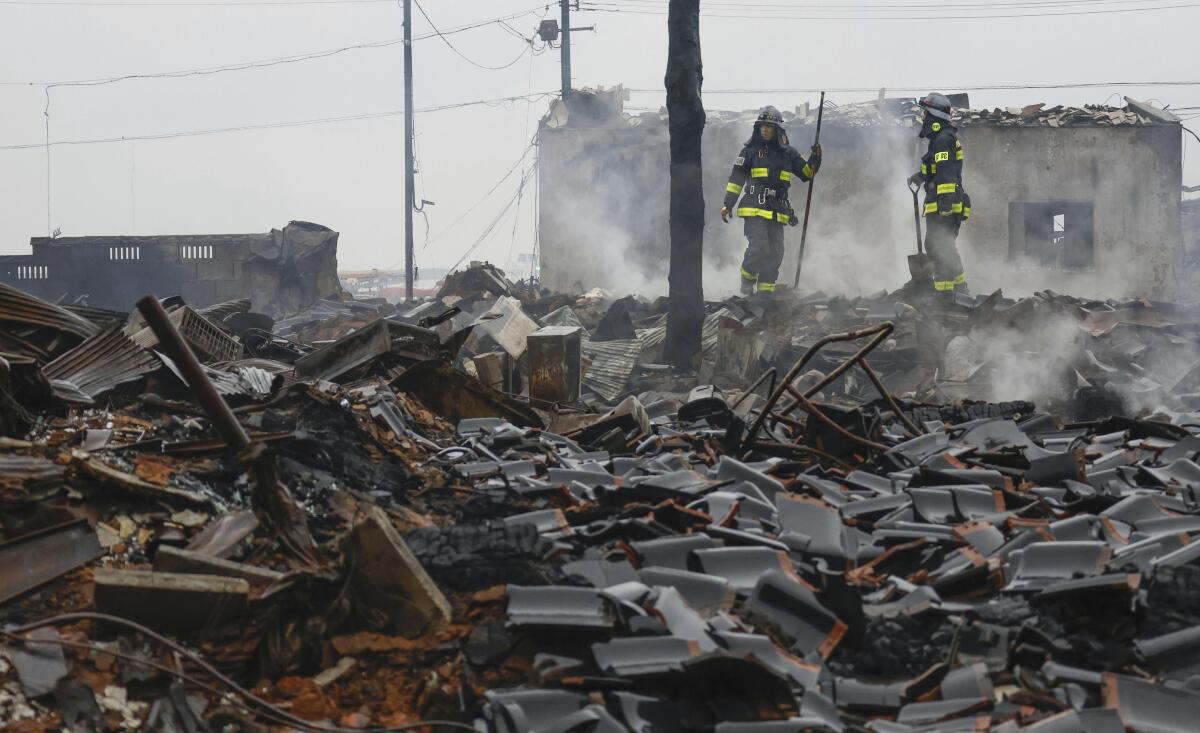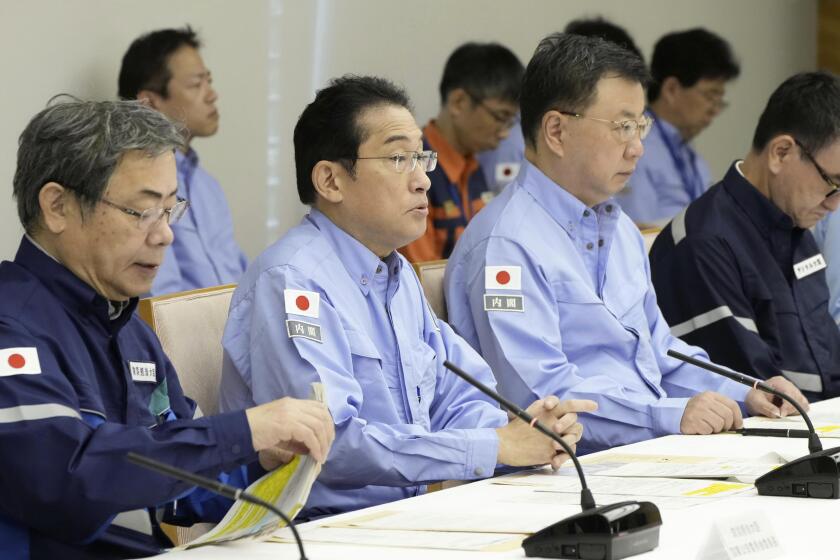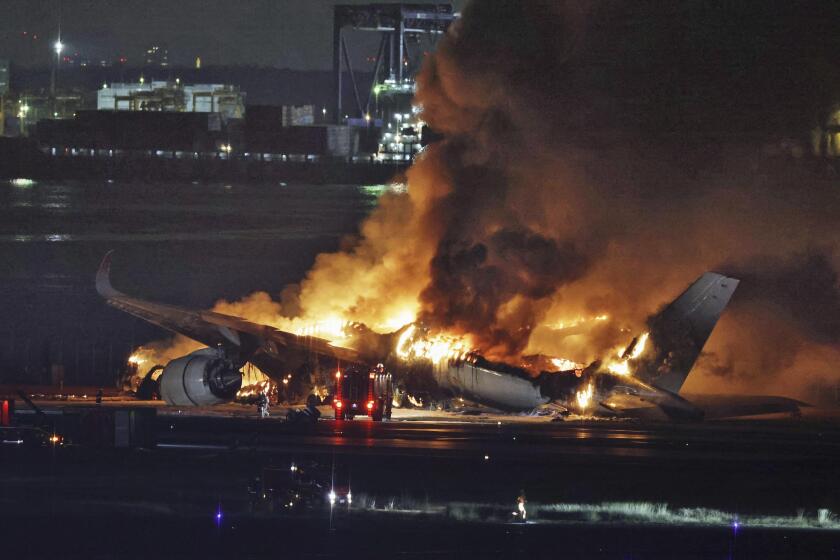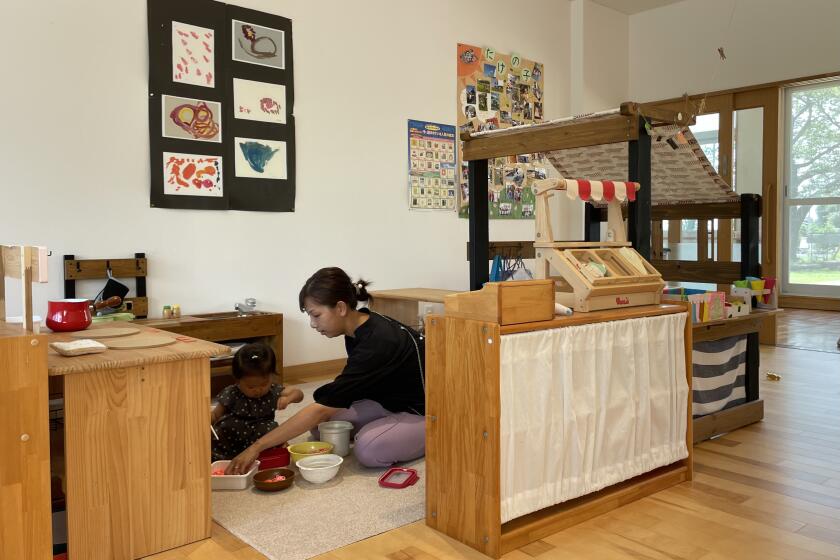Losses mount along Japan’s western coast after quake kills 84, with dozens still missing

- Share via
SUZU, Japan — His face hidden under a humble straw hat, the man stood silent, watching several helmeted rescue workers carefully lift his wife’s body from the rubble, wrapped in blue plastic and placed on a stretcher.
He wiped his weary face with a rag. His eyes were red.
The tragic scene in the city of Suzu was repeated across Japan’s Ishikawa prefecture and nearby regions on its western coastline after a magnitude 7.6 temblor Monday decimated houses, twisted and scarred roads, scattered boats like toys in the waters and prompted tsunami warnings.
The death toll stood at 84 as of Thursday.
Ishikawa officials said 48 of those who died were in the city of Wajima and 23 were in Suzu. Thirteen others were reported in five neighboring towns. More than 300 people have been injured, at least 26 seriously.
Those reported missing ballooned from 15 to 79 overnight, including a 13-year-old boy. Officials initially said 80 were missing but revised the number later.
Japan’s prime minister takes part in a televised earthquake disaster drill on the 100th anniversary of a temblor that devastated the Tokyo region.
What exacerbated matters was the number of people visiting to ring in the new year with their loved ones when the quake hit.
Prime Minister Fumio Kishida reinforced rescue operations with about 3,600 soldiers in addition to the initial 1,000. Their mission is to provide those affected with fresh water and hot meals, as well as set up bathing facilities for the 34,000 who lost their homes and are now staying in evacuation facilities.
Although Japan is reputed for relatively reliable disaster relief, essential supplies such as water, food and blankets have been running short.
“All we got was a couple of rice balls,” said Yasuo Kobatake, cupping his hand in a tiny ball to show how small the meal was. He has been staying with his wife at an elementary school, an impromptu evacuation center. He was given only a tiny paper cup half-filled with water that “vanished in a sip.”
Japan has committed to becoming carbon-neutral by 2050, but the legacy of the 2011 Fukushima nuclear catastrophe makes that goal harder to reach.
When the ground trembled, Kobatake had been about to put on his shoes to head out. Instead, he ran out of the house barefoot with just one sock on. That first temblor was followed by the main, more destructive quake, which flung him to the ground. A concrete wall came crashing down, barely missing him.
Kobatake can no longer access his destroyed house.
“So here I am with my wife sleeping beside all the others” in the shelter, he said. “We talk to each other and we try to encourage each other.”
Kobatake hoped help was on the way.
A passenger plane and a Japanese coast guard aircraft collide on the runway and burst into flames, killing 5 coast guard crew members.
However, many roads have been blocked by landslides or suffered cracks because of the strong quake, making it difficult for trucks delivering water and food to reach those in need. The hardest-hit spots were on the Noto Peninsula, the epicenter of the quake, connected by a narrow strip of land to the rest of the island of Honshu, making alternative routes scarce.
Snow is expected over the weekend, so quickly finding those trapped under the rubble has become even more pressing.
Three days after Monday’s quake, rescuers are still pulling out people alive from under debris. But time is running out. Experts categorize the first 72 hours as crucial to finding survivors.
Authorities warned that more quakes and tsunamis could follow, stressing the need for extra caution over the next few days. Plans are also underway to fly some evacuated people out to safer areas.
Get earthquake-ready in six weeks
From building a kit to buying insurance, our Unshaken newsletter course will help you prepare.
You may occasionally receive promotional content from the Los Angeles Times.
Aftershocks continued to rock the coastal areas near Noto, about 185 miles from Tokyo.
The quake set off tsunami warnings, followed by waves measuring more than 3 feet high in some places. The warnings have since been lifted.
The usual pastoral landscape of Ishikawa was replaced by gray stretches of ash and charred walls, where a fire broke out in Wajima city.
Cars sat askew on roads scarred with giant fissures. Lopsided houses missing roof tiles sat beside a home that the quake had flattened into a pile of wood. Boats floated belly-up in the bay.
Japan is confronting a depopulation crisis because of a precipitously falling birth rate, but one mountain town has bucked the trend — spectacularly.
The first day of trading of the new year on the Tokyo Stock Exchange, usually a celebratory affair with the ringing of a big bell and throngs of kimono-clad women, was marked with a moment of silence, as people bowed their heads to mourn the dead.
“I would like to express my heartfelt prayers for the souls of those who lost their lives, and my deepest sympathies to all those suffering from the disaster,” said Finance Minister Shunichi Suzuki.
Japan is prone to earthquakes, with many fault lines and volcanoes. A massive quake, tsunami and nuclear disaster in 2011 caused widespread damage in northeastern Japan.
So far, no major issues have been reported at nuclear plants following this week’s earthquake and aftershocks.
More to Read
Sign up for Essential California
The most important California stories and recommendations in your inbox every morning.
You may occasionally receive promotional content from the Los Angeles Times.

















